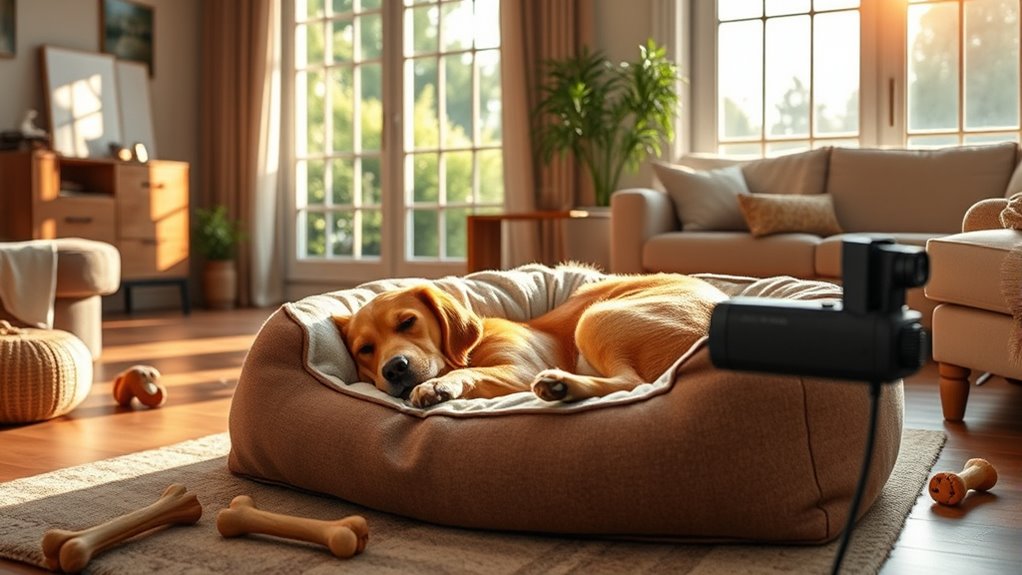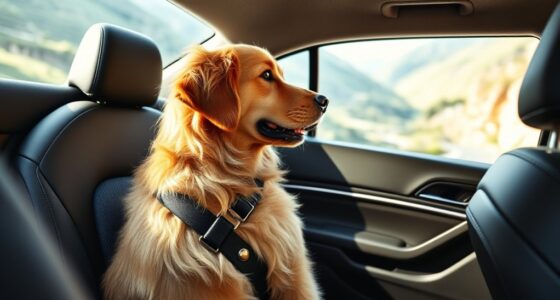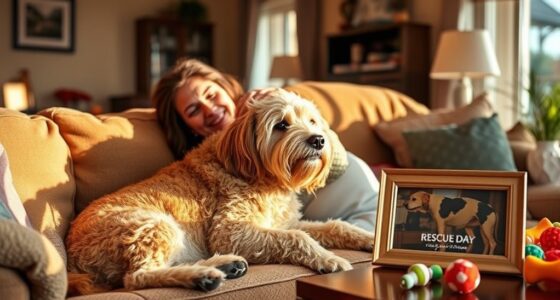To keep your dog safe and happy when you’re away, prepare your home by removing hazards and securing doors and windows. Create a cozy, enriching environment with comfortable resting spots, puzzle toys, and engaging activities. Use technology like cameras and two-way audio for monitoring and reassurance. Establish a routine for walks, meals, and playtime, and choose trustworthy pet care providers. If you stay attentive to stress signals and use smart solutions, your dog can enjoy a safe, happy time until you return.
Key Takeaways
- Secure doors, windows, and eliminate hazards to prevent escapes and injuries.
- Provide a cozy, enriched environment with toys, comfortable bedding, and minimal clutter.
- Use technology like remote cameras and two-way audio for monitoring and reassurance.
- Establish a consistent routine for feeding, walks, and play to reduce anxiety.
- Choose reliable pet caregivers and ensure the environment is safe, hygienic, and well-maintained.
Preparing Your Home for a Safe Absence
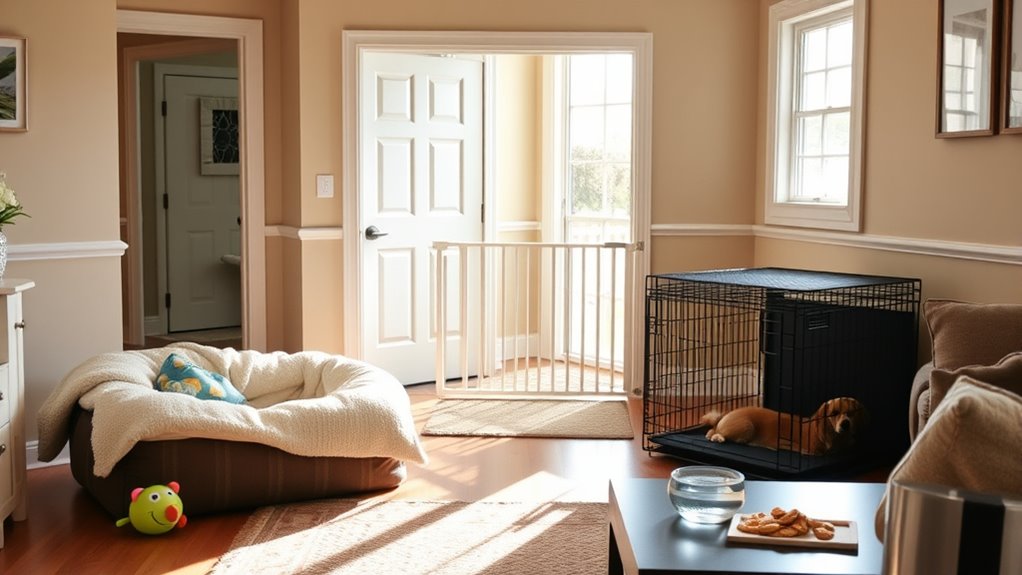
Before leaving your dog alone, take time to secure your home and minimize potential hazards. Prioritize home safety by removing anything that could harm your pet, such as sharp objects or toxic plants. Make sure doors and windows are securely closed to prevent escapes. Additionally, consider emergency preparedness by keeping emergency contacts, your veterinarian’s number, and a first aid kit accessible. Ensure your dog has access to fresh water and a safe space where they can rest comfortably. Check for electrical cords or small items that could be chewed and swallowed. Proper home safety measures can significantly reduce risks and keep your dog protected. Regularly inspecting your home for hazards such as spoiled or unsafe items is essential to prevent accidental ingestion. Securing the ventilation system is also important to prevent the buildup of dangerous gases like carbon monoxide. Utilizing the air purifier maintenance dos and don’ts can help ensure the air quality remains safe for your pet, especially if they are sensitive to airborne pollutants. Ensuring proper humidity levels within your home can also prevent respiratory issues and keep your pet comfortable. By proactively safeguarding your home and preparing for emergencies, you reduce risks and help your dog stay safe and calm during your absence. Planning ahead makes all the difference in keeping your furry friend protected.
Creating a Comfortable and Enriching Environment

Creating a comfortable and enriching environment helps your dog feel safe and engaged when you’re away. You should provide cozy resting spots, stimulating toys, and games that keep their mind active. Additionally, choose safe, dog-friendly decor to guarantee their space is both inviting and secure.
Cozy Resting Spaces
A cozy resting space is essential for your dog’s comfort and well-being when you’re away. Start by choosing a quiet, low-traffic area for the dog bed placement, ensuring your pup feels safe and secure. Position the bed away from drafts and direct sunlight to maintain a comfortable temperature. When selecting cozy blanket choices, opt for soft, washable fabrics that invite snuggling and provide warmth. Layering blankets can also add extra comfort and a sense of familiarity. Keep the area tidy and free of clutter to prevent any discomfort or stress. Remember, a well-placed dog bed with cozy blankets creates an inviting environment that helps your dog feel relaxed and secure during your absence. Additionally, incorporating comfortable and safe materials aligns with recommendations for creating a secure environment that promotes relaxation. Using durable and eco-friendly materials can also ensure the space remains safe and sustainable over time. Ensuring the space offers pressure relief can significantly enhance your dog’s comfort and support restful sleep. Choosing preppy dog names for a stylish touch can also enhance your pet’s environment by reflecting their personality and charm. To further enhance your dog’s comfort, consider researching appropriate bedding options that cater to their specific needs and preferences.
Stimulating Toys & Games
Adding stimulating toys and games to your dog’s resting area transforms it into an engaging environment that promotes mental and physical well-being. Puzzle toys and interactive games keep your dog occupied and mentally challenged, reducing boredom and anxiety. Consider these options:
- Provide puzzle toys that dispense treats, encouraging problem-solving.
- Incorporate interactive games like tug-of-war or hide-and-seek.
- Rotate toys regularly to maintain interest and novelty.
- Use puzzle feeders to combine feeding with mental stimulation.
- Ensure the environment remains clean and dry for optimal patch adhesion and effectiveness.
- Regularly inspect and maintain your dog’s toys and environment to ensure safety and longevity, similar to how bike components require routine checks to function properly.
- Create a dedicated play area within your home to encourage safe and supervised activity sessions. Additionally, choosing safe and durable toys can prevent choking hazards and ensure long-term use. Proper networking of toys and environment can also foster a sense of security and reduce separation anxiety in your dog.
These elements not only entertain your dog but also help prevent destructive behaviors. By enriching their environment with engaging toys and games, you support their happiness and health, making their alone time more fulfilling.
Safe, Doggy-Friendly Decor
To guarantee your dog feels safe and comfortable when you’re away, focus on designing a space filled with dog-friendly decor that supports their well-being. Use doggy friendly furniture that’s sturdy, non-toxic, and easy to clean, providing a cozy spot for rest and play. Incorporate pet safe plants to add greenery without risking toxicity if chewed. Avoid sharp edges and fragile decor that could harm your dog. Keep clutter minimal to reduce stress and prevent accidents. Soft, washable rugs and cushions create inviting areas for relaxation. Ensure there’s enough space for your dog to move freely and comfortably. Thoughtful decor not only makes your home more inviting but also reassures your pup, helping them feel secure and happy when you’re not around. Considering tableware materials that are safe and durable can also contribute to a pet-friendly environment. Additionally, incorporating digital literacy programs can help you stay informed about innovations in pet safety and comfort. Moreover, selecting decor made from materials similar to flat iron bikes that are durable and safe can further enhance your pet’s environment. Being aware of emerging technologies such as AI-powered monitoring systems can provide real-time updates on your pet’s well-being and safety.
Choosing the Right Dog-Sitting or Boarding Options
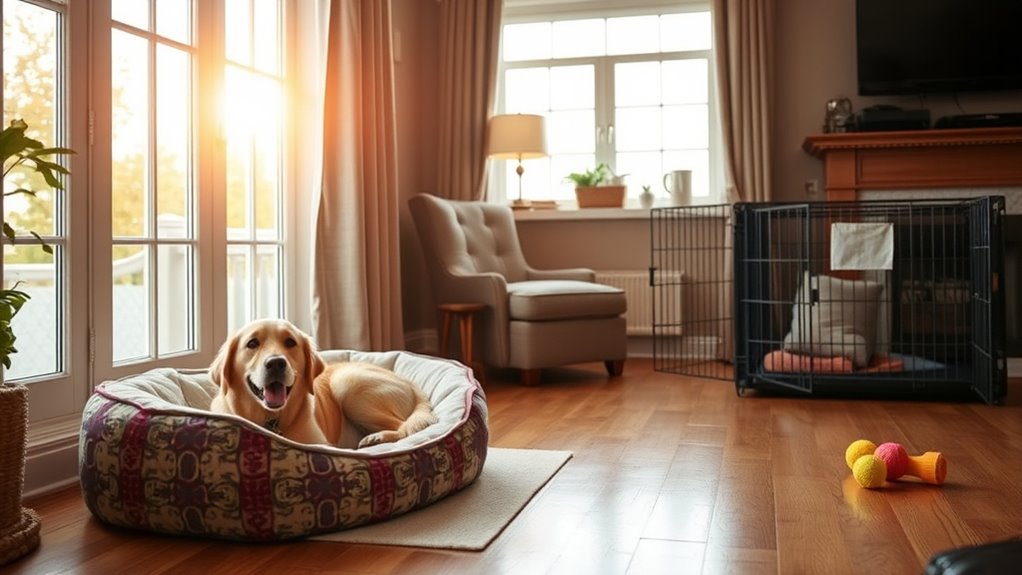
Finding the right dog-sitting or boarding option is essential to guarantee your pet’s safety and happiness while you’re away. When choosing professional caretakers, consider these key factors:
Choosing the right pet care ensures your dog’s safety and happiness when you’re away.
- Experience and Certifications: Ensure they have proper training and experience in pet sitting or boarding.
- Pet Sitting Etiquette: Observe how they interact with pets, showing patience and understanding.
- Facility Cleanliness: Check that the environment is hygienic and well-maintained.
- References and Reviews: Read feedback from other pet owners to gauge reliability and quality of care.
- It’s also important to evaluate their relationship building skills, as a trustworthy caregiver should foster a sense of comfort and security for your dog. Additionally, assessing their knowledge of pet health can help ensure your dog receives proper care in case of any medical needs. Developing a good caregiver trust is crucial for peace of mind when leaving your dog in their care. Moreover, understanding the significance of angel number soulmate connections might seem unrelated but can remind us of the importance of harmony and trust in the pet-care relationship.
Using Technology to Monitor and Communicate

Technology makes it easier to keep an eye on your dog and stay connected. With remote video monitoring, you can watch your pet anytime, while automated feedings and alerts guarantee they’re fed and safe. Two-way audio lets you talk to your dog, offering comfort even when you’re apart. Incorporating smart home devices can further enhance your pet’s safety and comfort, especially when integrated with home automation systems for seamless control. Utilizing pet-specific monitoring technology ensures tailored features that address your dog’s unique needs. Regularly updating your devices and security measures can help protect your home environment and your pet’s well-being.
Remote Video Monitoring
Using remote video monitoring allows you to keep a close eye on your dog even when you’re not home. With virtual security, pet cameras become essential tools that offer real-time visuals and communication. To maximize their benefits, consider these features:
- Live streaming and remote viewing on your smartphone or tablet
- Two-way audio to talk to your dog and provide reassurance
- Motion detection alerts that notify you of activity
- High-definition video quality for clear visuals
These pet camera features help you monitor your dog’s behavior, ensure they’re safe, and even comfort them with your voice. By utilizing these tools, you create a virtual security system that keeps you connected and provides peace of mind, no matter where you are.
Automated Feedings & Alerts
Remote video monitoring keeps you connected to your dog’s daily activities, but managing their meals and ensuring they’re safe requires additional tools. Automatic feeders allow you to schedule meals precisely, so your dog stays on a consistent eating routine even when you’re away. Many models can be controlled remotely via smartphone, giving you peace of mind. Pair these with alert notifications that notify you if your dog has eaten, if the feeder encounters a problem, or if there’s unusual activity around their feeding area. These alerts help you respond quickly to potential issues, ensuring your pet’s health and safety. Using automated feeding systems combined with alert notifications keeps your dog well-fed and monitored, giving you confidence that they’re happy and safe, even in your absence.
Two-Way Audio Communication
Two-way audio communication allows you to hear your dog’s sounds and respond in real-time, bridging the gap when you’re apart. This technology lets you check on your pup, calm bark control issues, and even participate in vocal training. To make the most of it, consider these tips:
- Use two-way audio to soothe your dog during anxious moments or loud noises.
- Reinforce bark control by calmly talking through the device when your dog barks excessively.
- Practice vocal training by encouraging commands or praise during your interactions.
- Monitor your dog’s environment, ensuring they’re comfortable and not distressed.
This setup helps maintain your bond, reduces separation anxiety, and promotes a well-behaved, happy pup even when you’re away.
Establishing a Routine and Providing Mental Stimulation
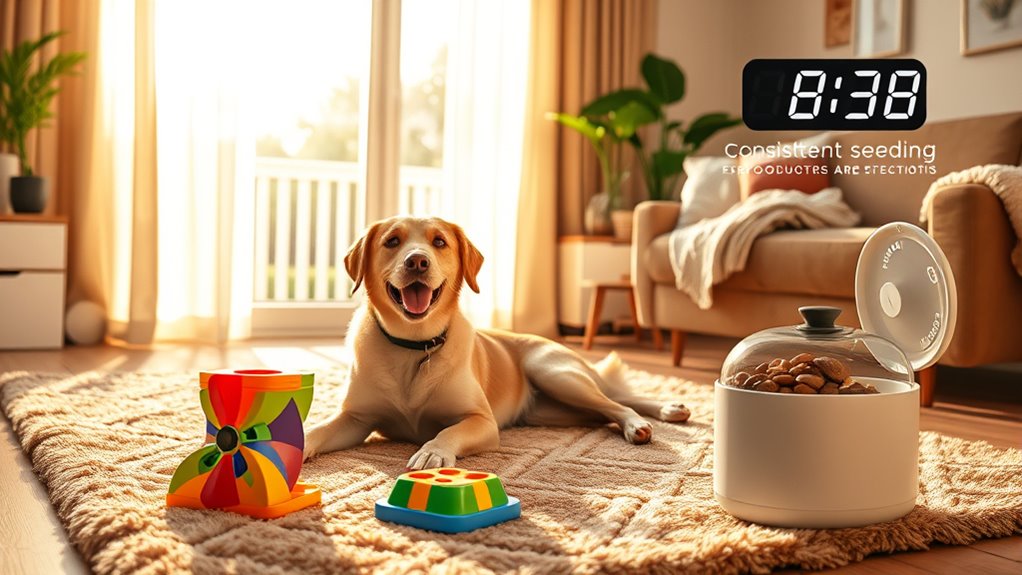
Establishing a consistent routine and offering mental stimulation are essential for keeping your dog content and well-behaved when you’re away. Dogs thrive on daily consistency, which helps reduce anxiety and creates a sense of security. Incorporate activities that promote mental engagement, like puzzle toys or training sessions, to keep their minds active. A predictable schedule for walks, meals, and playtime ensures your dog knows what to expect. Use this table to plan your routine:
| Morning | Evening |
|---|---|
| Walk + Breakfast | Play + Dinner |
| Training Session | Relaxation Time |
| Puzzle Toy | Short Walk |
| Cuddle Time | Bedtime Routine |
Sticking to this routine provides comfort and mental stimulation, making your dog happier and calmer when alone.
Recognizing Signs of Stress and Ensuring Well-Being
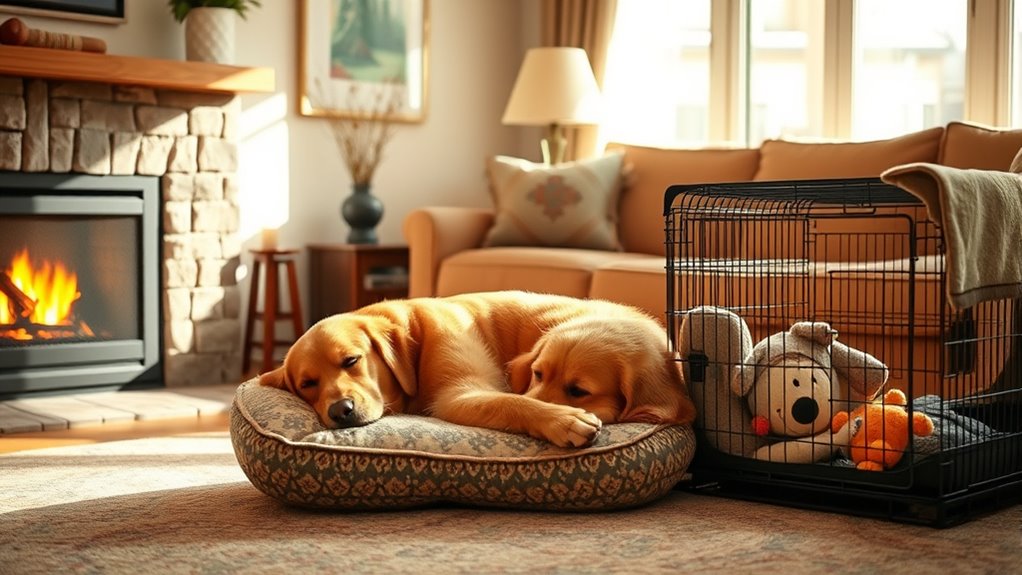
Understanding the signs of stress in your dog is essential for ensuring their well-being when you’re away. Recognizing behavior cues helps you address their needs early. Common signs include excessive barking, pacing, drooling, and panting, which indicate anxiety. To support their well-being, consider these stress reduction techniques:
- Observe subtle behavior cues to identify stress early.
- Create a calm environment with soothing sounds or scents.
- Use puzzle toys to keep their mind engaged.
- Maintain a consistent routine to reduce anxiety triggers.
Implementing these strategies helps your dog feel secure and reduces stress. When you notice signs of distress, acting promptly and employing stress reduction techniques can make a significant difference, ensuring your dog remains happy and relaxed even when you’re not home.
Frequently Asked Questions
How Can I Identify if My Dog Has Separation Anxiety?
You can spot dog separation signs by observing anxiety symptoms like excessive barking, whining, or destructive behavior when you’re not around. If your dog tries to escape or shows signs of stress, it’s likely experiencing separation anxiety. Pay attention to their behavior before you leave, and notice how they act when you return. Recognizing these anxiety symptoms early helps you address their needs and reduce their stress effectively.
What Are the Safest Toys and Treats for My Dog?
When choosing toys and treats for your dog, opt for safe options like interactive puzzles and durable chew toys. Interactive puzzles stimulate your dog’s mind and help prevent boredom, while durable chew toys satisfy their natural chewing instincts. Always check labels for non-toxic materials and avoid small parts that could be swallowed. By selecting safe, engaging toys and treats, you guarantee your dog stays happy and healthy when you’re apart.
How Do I Choose a Trustworthy Pet Sitter or Boarding Facility?
When choosing a pet sitter or boarding facility, you want to guarantee your dog’s safety and comfort. Look for providers who conduct thorough background checks and prioritize facility cleanliness. Visit in person to observe how staff interact with animals and check for proper sanitation. Ask about their experience, policies, and emergency procedures. Trust your instincts and select a place where your dog feels secure, happy, and well-cared for while you’re away.
What Signs Indicate My Dog Is Distressed or Unwell?
You want to know if your dog is distressed or unwell, and watching their body language helps. Look for signs of discomfort like excessive panting, whining, or trembling. Pay attention to changes in posture, such as a tucked tail or flattened ears, and behaviors like loss of appetite or lethargy. Recognizing these signs early permits you to seek vet care promptly and ensure your dog stays safe and comfortable.
How Can I Help My Dog Adjust to Being Alone?
Helping your dog adjust to being alone can feel like teaching a puppy to swim—slowly and with patience. You can start with short training exercises and gradually increase alone time. Use calming techniques like soothing music or treats to comfort your pup. Consistency is key; over time, these steps help build trust and confidence, making separation easier for your dog and easing your worries.
Conclusion
When you prepare your home and choose the right care, your dog’s happiness blossoms like a well-tended garden. By creating a safe, stimulating environment and staying connected, you turn absences into opportunities for growth and comfort. Remember, your thoughtful efforts are the guiding stars that keep your furry friend safe and content, even when you’re apart. With a little planning, you’ll both navigate your time together and apart with love and confidence.

